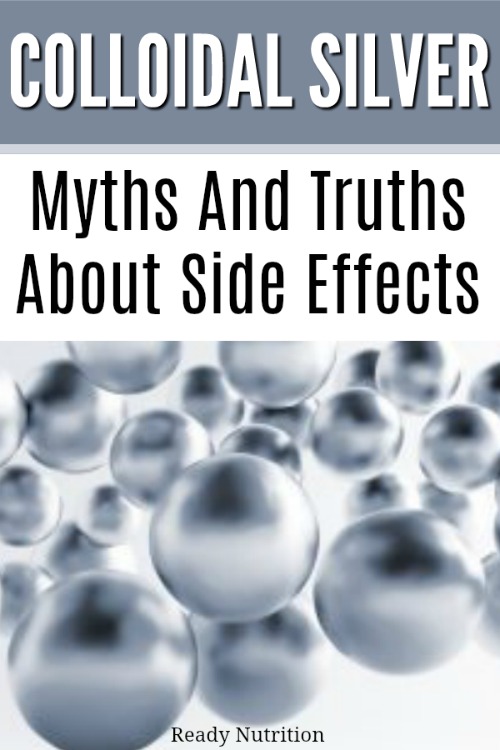
Colloidal silver is often a topic of controversy. Mentioning it to those who are strict believers in only Western medicine can often make you feel like an insane witch doctor. But we’ll break down the myths and deliver some truths about the side effects, so you can make an informed decision for yourself.
Colloidal silver has gotten a bad rap since the Food and Drug Administration made a claim in 1999 (almost 20 years ago) that there is no scientific evidence to support the use of colloidal silver. If one translates that from “government-speak,” it basically means the FDA has not used government funds to study something not recommended by the government because they haven’t been paid to do so. They want you to use the medication and supplements lobbyists pay them to defend and promote. The FDA also proceeds to warn potential users on their website (who are often simply looking for information) about the danger of colloidal silver and why consumers should steer clear before bragging about “taking down” certain companies for “making false claims” about colloidal silver – what most government agencies are declaring as “snake oil.”
The FDA also warns about a side effect called argyria, and herein, we’ll focus on the myths and truths of this well-known, but misunderstood side effect.
The most well-known, and extremely rare side effect of ingesting colloidal silver is argyria, a bluish-gray discoloration of the skin, which is usually permanent. This occurs when a person ingests an excess amount of silver. Argyria results from the deposition of silver in the dermis and also from the silver-induced production of melanin. Although silver has been shown to be uniformly deposited in exposed and unexposed sections of the skin, the increased pigmentation becomes more pronounced in areas exposed to sunlight (such as the face and hands) due to the photoactivated reduction of the metal.
However, based on the government’s own studies, it would take a lot of silver to cause argyria. The smallest amount of silver known to cause the condition in adults, according to a study done by the Environmental Protection Agency from the use of any silver compound (including silver salts) is 900 mg of silver taken orally in one year. According to the book, Colloidal Silver: A Literature Review: Medical Uses, Toxicology & Manufacture by John Hill, D.C., in order to reach an intake level of 900 mg of silver over the course of one year, an individual would have to consume a whopping 380 – 8 oz. bottles of 10 PPM colloidal silver product during the course of the year. That’s a lot of silver chugging.
Since the suggested adult daily dosage on most commercial colloidal silver products is about 1 teaspoon daily, this means that an individual would have to consume nearly 48 times the normal adult dosage, each and every day for a year to reach the lowest level of silver intake ever known to cause argyria in an adult. The EPA’s standards for the amount of silver that can be safely consumed in drinking water is .005 milligrams per kilogram of body weight per day (EPA RED document page 2, 4th paragraph). The .005 milligrams per kilogram of body weight claimed in the EPA RED document to be a safe level of daily silver intake includes silver from all sources, including air, water, and food.
Since it’s almost impossible to tell how much silver is in your food and water supply, dosages should be adjusted accordingly and for your own personal size. Fortunately, a company called Invision International Health Solutions has analyzed the EPA’s figures and has determined that they can be further broken down into “drops per day” formula. They’ve determined how to calculate the amount of colloidal silver you can take daily, based upon your body weight, using the EPA’s own figures. You can click here for a free dosage report.
By simply following recommended dosages, argyria is easily avoided. But what about other side effects? Well, there aren’t any, actually, according to doctors. So let’s focus on what problems can arise if one happens to ingest so much colloidal silver they actually get argyria -the side effects of the side effect if you will.
Although the deposition of silver is permanent, it is not associated with any adverse health effects. No pathologic changes or inflammatory reactions have been shown to result from the silver deposition in the dermis or argyria. In fact, in one case of argyria, medical researchers Hill and Pillsbury stated back in 1939, “The ordinary clinical use of colloidal silver compounds practically never gives rise to any gross untoward effect other than argyria.” Meaning the one and only side effect of a colloidal silver overdose is purely cosmetic – a discoloration of the skin. An excerpt from the aforementioned EPA study has also clearly stated in their document titled Silver (CASRN 7440-22-4): “The critical effect in humans ingesting silver is argyria, a medically benign but permanent bluish-gray discoloration of the skin.” So argyria itself (the only side effect of ingesting colloidal silver) is “medically benign.” This actually makes colloidal silver one of the safest supplements on shelves today, from a toxicological point of view.
But what’s important to remember about argyria, and all side effects is that ALL things are harmful to us when taken in doses above what the body can handle. Antibiotics, water, and vitamins can be very beneficial to the human body and health. But crossing the line and overdosing on yes, even water, can have harmful and fatal effects. Living life in a perpetual state of fear over something as innocent and mild as colloidal silver is a bit misguided. It’s imperative for nutritional supplement users to understand the safe and responsible use of any nutritional supplement – including colloidal silver – so that obvious risks can be avoided while the full healthful benefits of the nutritional supplement are enjoyed.
*DISCLAIMER: This article is for informational purposes only. It is not intended to diagnose or be used as medical advice.

This article was originally published at Ready Nutrition™ on May 21st, 2018







Love this article, thank you so much for clarifying while also offering the critical details involved. I’ve been on silver for 5 years and have yet to even get a cold, I use it on all my wounds and they heal beautifully- it’s immune magic : )
I’m looking for some product but how do I know which is the best for my family? are they rated? I’ve heard that non IONIC is the best but how strong or how many ppm should I buy ? what are the best brands? So many questions and so little TRUSTWORTHY information. Thank You Ken